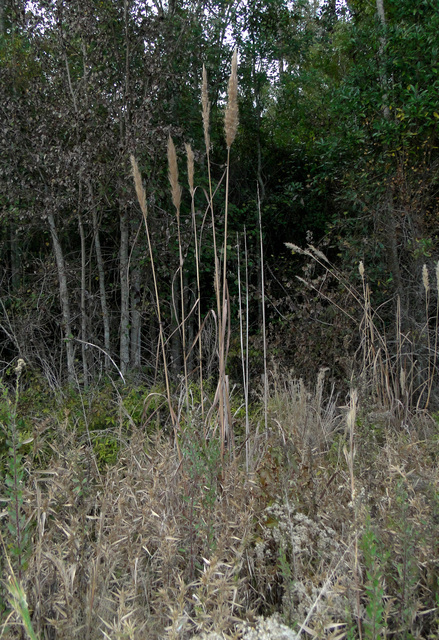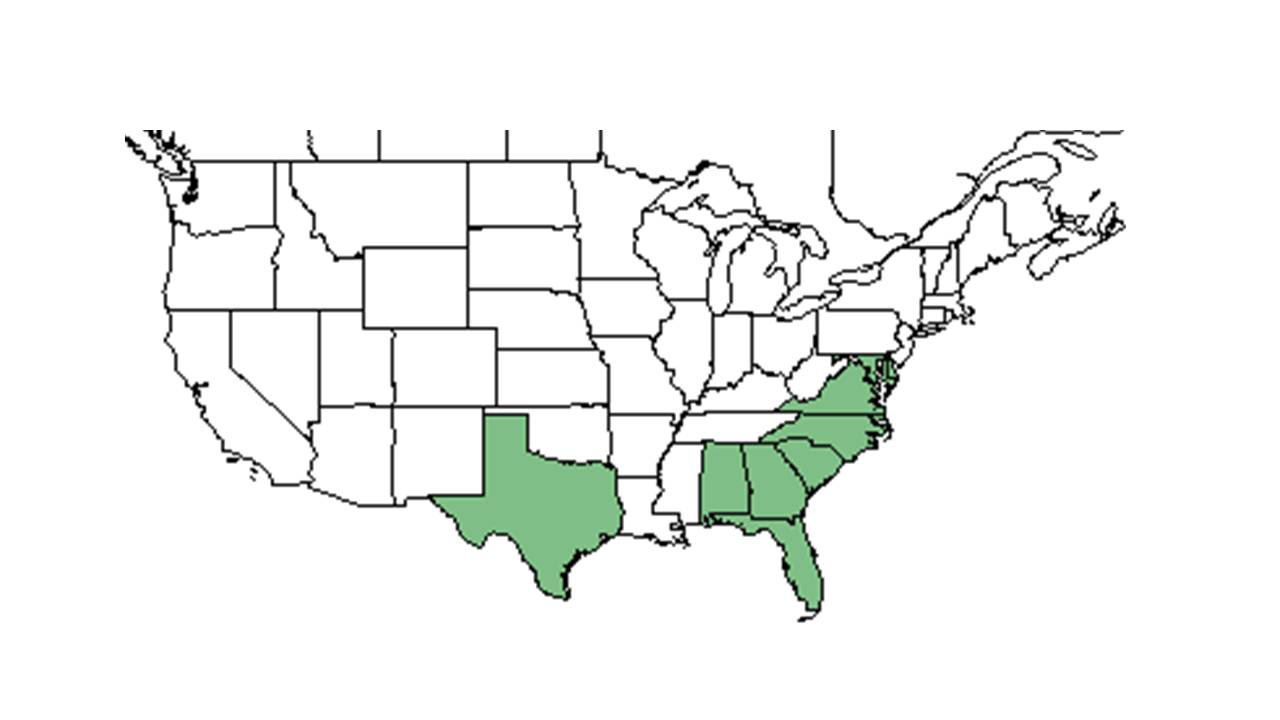Difference between revisions of "Erianthus coarctatus"
| Line 33: | Line 33: | ||
==Ecology== | ==Ecology== | ||
===Habitat=== <!--Natural communities, human disturbed habitats, topography, hydrology, soils, light, fire regime requirements for removal of competition, etc.--> | ===Habitat=== <!--Natural communities, human disturbed habitats, topography, hydrology, soils, light, fire regime requirements for removal of competition, etc.--> | ||
| − | In the Coastal Plain in Florida, ''E. coarctatus'' can be found in mesic flatwoods, lake shores, pinewoods, sloughs, along canal banks, swales, hillside bogs, dried up ponds, and pine-oak woodlands. It can also be found in roadside ditches and cleared pine flatwoods. Soil types include loamy sand and sandy peat. It is found in the lowland areas of old growth longleaf pine sandhill community at the Wade Tract, Thomas County, Georgia.<ref name=fsu>Florida State University Robert K. Godfrey Herbarium database. URL: http://herbarium.bio.fsu.edu. Last accessed: July 2015. Collectors: Loran C. Anderson, Robert K. Godfrey, J. B. Morrill, R. Kral, Jean W. Wooten. States and Counties: Florida: Dixie, Duval, Franklin, Gadsden, Gulf, Jackson, Jefferson, Leon, Nassau, Wakulla. Compiled by Tall Timbers Research Station and Land Conservancy.</ref> | + | Generally, this species can be found in ditches, marshes, swamps, and clay-based Carolina bays.<ref name= "weakley"/> In the Coastal Plain in Florida, ''E. coarctatus'' can be found in mesic flatwoods, lake shores, pinewoods, sloughs, along canal banks, swales, hillside bogs, dried up ponds, and pine-oak woodlands. It can also be found in roadside ditches and cleared pine flatwoods. Soil types include loamy sand and sandy peat. It is found in the lowland areas of old growth longleaf pine sandhill community at the Wade Tract, Thomas County, Georgia.<ref name=fsu>Florida State University Robert K. Godfrey Herbarium database. URL: http://herbarium.bio.fsu.edu. Last accessed: July 2015. Collectors: Loran C. Anderson, Robert K. Godfrey, J. B. Morrill, R. Kral, Jean W. Wooten. States and Counties: Florida: Dixie, Duval, Franklin, Gadsden, Gulf, Jackson, Jefferson, Leon, Nassau, Wakulla. Compiled by Tall Timbers Research Station and Land Conservancy.</ref> |
===Phenology=== <!--Timing off flowering, fruiting, seed dispersal, and environmental triggers. Cite PanFlora website if appropriate: http://www.gilnelson.com/PanFlora/ --> | ===Phenology=== <!--Timing off flowering, fruiting, seed dispersal, and environmental triggers. Cite PanFlora website if appropriate: http://www.gilnelson.com/PanFlora/ --> | ||
Revision as of 20:12, 8 May 2019
| Erianthus coarctatus | |
|---|---|

| |
| Saccharum coarctatum (synonym) shown. Photo by ©Bobby Hattaway 2011 Discoverlife.org | |
| Scientific classification | |
| Kingdom: | Plantae |
| Division: | Magnoliophyta – Flowering plants |
| Class: | Liliopsida – Monocotyledons |
| Order: | Cyperales |
| Family: | Poaceae ⁄ Gramineae |
| Genus: | Erianthus |
| Species: | E. coarctatus |
| Binomial name | |
| Erianthus coarctatus (Fernald) R. Webster | |

| |
| Natural range of Erianthus coarctatus from USDA NRCS Plants Database. | |
Common name: Compressed plumegrass; brown plume grass
Contents
Taxonomic notes
Synonyms: Erianthus brevibarbis Michaux; Saccharum coarctatum (Fernald) R.D. Webster; Erianthus coarctatus Fernald var. coarctatus; Erianthus coarctatus Fernald var. elliottianus Fernald
Description
Erianthus are "coarse perennials from hardened bases or short rhizomes; culms usually purplish, nodes usually, glabrous or upper appressed pubescent, internodes usually glabrous. Leaves primarily cauline; blades scaberulous, usually densely long hirsute above ligule; sheaths usually glabrous; ligules membranous, ciliate, 1-4 mm long; collars long-hirsute. Panicle solitary, terminal, ovoid to ellipsoid. Racemes numerous, most ascending, joints and pedicels subequal, 2-6 mm long, scaberulous or villous. Spikelets in pairs, fertile, sessile and pedicellate, yellowish to purplish, ovoid. Glumes cartilaginous, acuminate, subequal; lemmas and paleas hyaline to purplish, shorter than glumes; callus usually bearded. Grain reddish, ellipsoid, 2-3.5 mm long."[1]
Specifically, for this species, they grow "culms 1-1.5 m tall. Blades to 4 dm long and 1 cm wide. Panicle tawny or purplish, 3-3.5 dm long, usually 3-5 cm broad; rachis villous. Raceme nearly erect, appressed. Spikelets usually scaberulous, 6-9 mm long, awns terete, scaberulous, nearly straight, 2-3 cm long; callus beard slightly shorter than to equaling spikelet. Grain 3 mm long."[1]
Distribution
It can be found in the United States from Delaware and Maryland south to Florida, and west to Texas.[2]
Ecology
Habitat
Generally, this species can be found in ditches, marshes, swamps, and clay-based Carolina bays.[2] In the Coastal Plain in Florida, E. coarctatus can be found in mesic flatwoods, lake shores, pinewoods, sloughs, along canal banks, swales, hillside bogs, dried up ponds, and pine-oak woodlands. It can also be found in roadside ditches and cleared pine flatwoods. Soil types include loamy sand and sandy peat. It is found in the lowland areas of old growth longleaf pine sandhill community at the Wade Tract, Thomas County, Georgia.[3]
Phenology
Flowers and fruits August through November.[3]
Conservation and management
Cultivation and restoration
Photo Gallery
References and notes
- ↑ 1.0 1.1 Radford, Albert E., Harry E. Ahles, and C. Ritchie Bell. Manual of the Vascular Flora of the Carolinas. 1964, 1968. The University of North Carolina Press. 160-3. Print.
- ↑ 2.0 2.1 Weakley, A. S. (2015). Flora of the Southern and Mid-Atlantic States. Chapel Hill, NC, University of North Carolina Herbarium.
- ↑ 3.0 3.1 Florida State University Robert K. Godfrey Herbarium database. URL: http://herbarium.bio.fsu.edu. Last accessed: July 2015. Collectors: Loran C. Anderson, Robert K. Godfrey, J. B. Morrill, R. Kral, Jean W. Wooten. States and Counties: Florida: Dixie, Duval, Franklin, Gadsden, Gulf, Jackson, Jefferson, Leon, Nassau, Wakulla. Compiled by Tall Timbers Research Station and Land Conservancy.